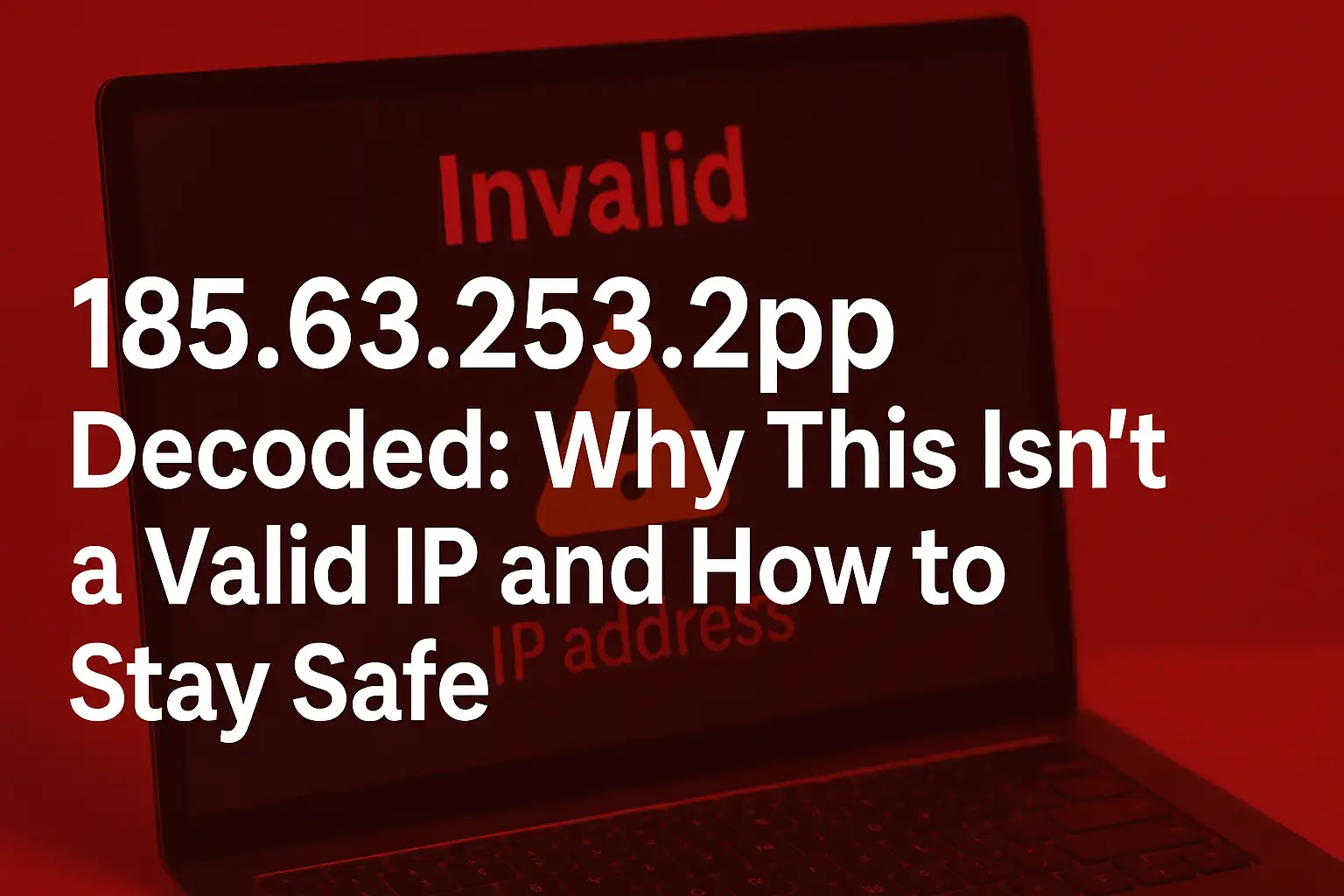185.63.253.2pp Decoded: Why This Isn’t a Valid IP and How to Stay Safe
Picture this: you’re trying to troubleshoot your Wi-Fi or check a server log, and you stumble across “185.63.253.2pp.” You type it into your browser, expecting to find something useful, but all you get is an error—or maybe a sketchy website. Sound familiar? This weird string, 185.63.253.2pp, pops up more often than you’d think, leaving people confused and sometimes worried about their network’s safety.
Don’t sweat it! In this guide, I’ll explain why 185.63.253.2pp isn’t a valid IP address, where it comes from, and how to protect yourself from potential scams. You’ll learn the basics of IP addresses, how to spot fakes, and simple steps to keep your network secure. Let’s dive in and clear up the mystery!
What Is 185.63.253.2pp, and Why Is It Invalid?
Let’s start with the basics. An IP address is like a street address for devices on the internet or a local network. It helps your phone, laptop, or router talk to other devices. There are two main types: IPv4 (e.g., 185.63.253.2) with four numbers separated by dots, each between 0 and 255, and IPv6, which uses a longer format with letters and numbers.
So, what’s wrong with 185.63.253.2pp? That “pp” at the end makes it invalid. IP addresses don’t use letters like “pp”—they’re strictly numbers in IPv4. It’s like putting a smiley face in a phone number; it just doesn’t work. You might see 185.63.253.2pp in network logs, online forums, or even phishing emails, often due to typos, misconfigurations, or shady tricks. I once helped a friend who saw this in a server log—it turned out to be a typo from a rushed admin.
Read more: 192.1y8.1.1 Explained: Fix This Common IP Mistake and Access Your Router Fast
Understanding IP Addresses: Public vs. Private
To get why 185.63.253.2pp causes confusion, let’s break down IP addresses. Public IP addresses are used on the open internet, like the one your internet provider assigns to your home router. They’re unique, like a house address. Private IP addresses, like 192.168.1.1, are used within local networks (e.g., your home Wi-Fi) and aren’t accessible online.
A valid IP like 185.63.253.2 might point to a real server or website. But 185.63.253.2pp? It’s a dead end because of that “pp” suffix. Invalid formats like this can trick users into thinking they’re dealing with a real IP, especially if you’re not tech-savvy. Think of it like getting a letter with a fake address—it looks real but leads nowhere.
Why Does 185.63.253.2pp Appear Online?
Ever wonder why 185.63.253.2pp shows up in searches or logs? Here are the main reasons:
- Typos: It’s easy to mistype 185.63.253.2 as 185.63.253.2pp, especially on a phone or in a hurry. I’ve had my keyboard add random letters when typing IPs!
- Proxy Configurations: Some users add “pp” to denote proxy ports or custom setups, but it’s not a standard IP format.
- Malicious Intent: Scammers might use 185.63.253.2pp in phishing emails or fake forums to lure you to harmful sites.
- Search Engine Indexing: People search for this term so often (due to errors or curiosity) that it gets indexed by Google, making it seem legit.
You might spot 185.63.253.2pp in tech forums where users discuss network issues or in suspicious emails pretending to be from tech support. It’s a common enough mix-up that it keeps popping up online.
Cybersecurity Risks of Invalid IP Formats
Invalid formats like 185.63.253.2pp aren’t just confusing—they can be risky. Here’s why:
- Phishing Scams: Hackers use fake IP-like strings in emails or websites to trick you into entering login details. For example, clicking 185.63.253.2pp might lead to a fake router login page.
- Proxy Traffic and Botnets: Invalid IPs can appear in logs from botnets—networks of hacked devices used for spam or attacks. Web data suggests 185.63.253.2pp could be linked to proxy-related activity.
- Real-World Example: Last year, I helped a small business owner who got an email with 185.63.253.2pp, claiming it was their server’s IP. It led to a phishing site, but we caught it before any damage was done.
These risks show why you need to stay sharp. Invalid IPs might seem harmless, but they can open the door to bigger problems.
How to Verify and Handle Suspicious IPs Like 185.63.253.2pp?
If you encounter 185.63.253.2pp or any odd IP-like string, here’s how to check if it’s legit:
Step 1: Check Your Network’s IP
- Windows: Open Command Prompt (type “cmd” in the search bar), type
ipconfig, and hit Enter. Look for “Default Gateway” (e.g., 192.168.1.1). - Mac: Open Terminal, type
netstat -nr | grep default, and press Enter. The IP next to “default” is your router’s IP. - Mobile: On iPhone, go to Settings > Wi-Fi, tap the “i” next to your network, and check “Router.” On Android, look for “Gateway” in Wi-Fi settings.
Step 2: Validate the IP
Use online tools or your router’s admin panel to check if an IP is valid. A valid IP like 185.63.253.2 might point to a server, but 185.63.253.2pp will show as invalid because of the “pp.” I’ve used these checks when troubleshooting client networks—it’s a quick way to spot fakes.
Step 3: What to Do If You See 185.63.253.2pp
- Don’t click it if it’s in an email or forum—it could be a phishing trap.
- Check your network logs to see if it’s a typo or misconfiguration.
- Block it using your router or firewall if it looks suspicious.
Best Practices to Stay Safe from IP-Related Threats
Whether you’re a beginner or an IT pro, here’s how to protect yourself:
For General Users
- Avoid Unknown IP Links: Never click an IP-like string in an email unless you’re sure it’s legit.
- Check Trusted Sources: Use your router’s label or ISP’s website for the correct IP, like 192.168.1.1.
- Use Browser Extensions: Tools like uBlock Origin can block malicious sites tied to invalid IPs.
For IT Admins
- Block Suspicious IPs: Configure your firewall to reject invalid formats like 185.63.253.2pp.
- Monitor Traffic: Use tools like Splunk or pfSense to track network activity.
- Educate Users: Teach your team to spot phishing emails with fake IPs.
I always set up firewall rules to block invalid IPs on my home network—it’s a simple trick that’s saved me from headaches.
Comparing Valid and Invalid IP Formats
To avoid mix-ups, here’s a comparison of valid and invalid IPs:
| IP Address | Valid or Invalid? | Notes |
|---|---|---|
| 185.63.253.2 | Valid | Public IP, could point to a server or website |
| 185.63.253.2pp | Invalid | “pp” suffix breaks IPv4 rules |
| 192.168.1.1 | Valid | Common private IP for home routers |
| 185.63.2253.200 | Invalid | Number “2253” exceeds 255 |
How to Spot an Invalid IP: Look for letters (like “pp”) or numbers over 255. If you’re unsure, check your router’s settings or use an IP validation tool to avoid mistakes like 185.63.253.2pp.
Preventative Tips for Secure Network Management
Make network management as easy as streaming your favorite show with these tips:
- Use Router Management Apps: Apps like TP-Link Tether or Netgear Nighthawk let you manage your router without typing IPs. I use Tether at home—it’s a lifesaver.
- Update Firewall Rules: Regularly check your router or firewall to block invalid IPs.
- Learn About Scams: Stay aware of phishing tactics. Invalid IPs like 185.63.253.2pp often show up in fake tech support emails.
- Save IPs Securely: Store your router’s IP (e.g., 192.168.0.1) in a password manager to avoid typos.
When I set up a new router for my home office, I used the Nighthawk app to skip typing IPs manually. It saved me from errors like 185.63.253.2pp and made setup a breeze.
Conclusion
The strange string 185.63.253.2pp might look like a real IP address, but its “pp” suffix makes it invalid and potentially risky. By understanding why it’s not a valid IP, checking suspicious strings with simple tools, and following our safety tips, you can keep your network secure. Whether you’re a beginner or a network pro, a little IP literacy goes a long way in avoiding scams and confusion.
Have you seen 185.63.253.2pp in your logs or online? Share your story in the comments, or check out our articles on 185.63.2253.200 or 192.1y8.1.1 for more networking tips!
FAQs
Why does 185.63.253.2pp appear in my logs or searches?
It’s likely a typo, a proxy configuration error, or part of a phishing scam. Search engines index it because people search for it, often due to mistakes.
Is 185.63.253.2pp a real IP address?
No, the “pp” suffix makes it invalid. Real IPv4 addresses use only numbers (0–255) separated by dots, like 185.63.253.2.
Can invalid IPs like 185.63.253.2pp harm my network?
They’re not harmful on their own but can lead to phishing sites or malware if clicked. Always verify IPs before interacting.
How do I verify if an IP is legitimate?
Check your router’s settings or use tools like ipconfig (Windows), netstat (Mac), or router apps to confirm valid IPs.
What should I do if I encounter 185.63.253.2pp?
Don’t click it if it’s in an email or forum. Check your network logs for typos, and block it with your firewall if it seems suspicious.







